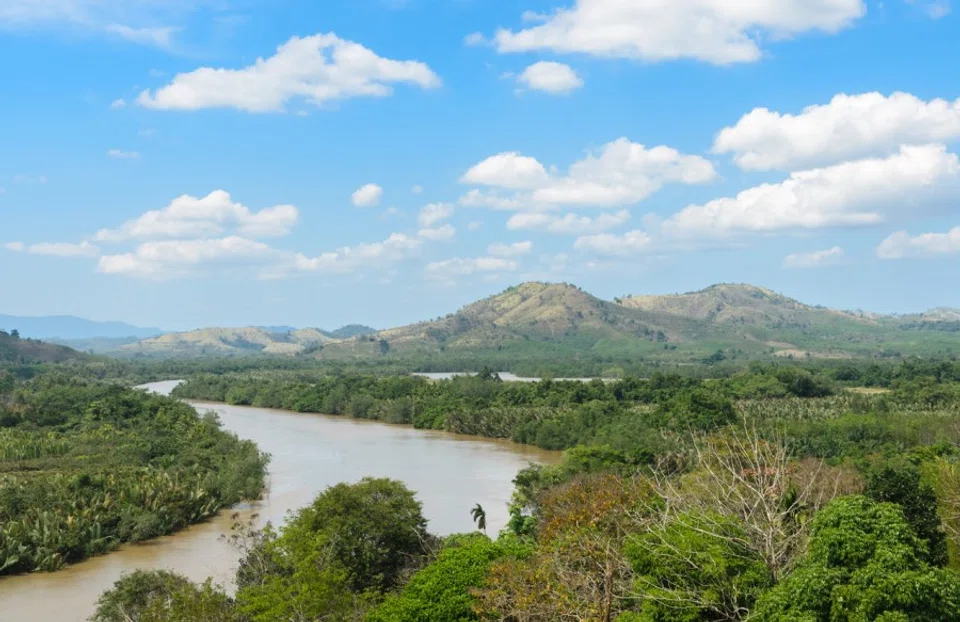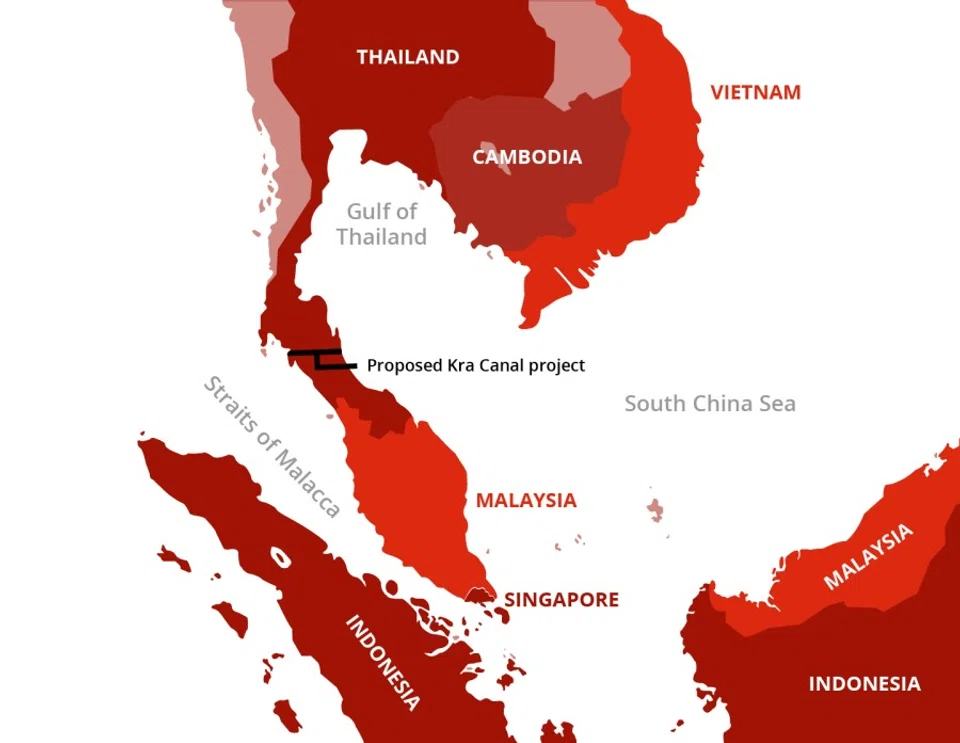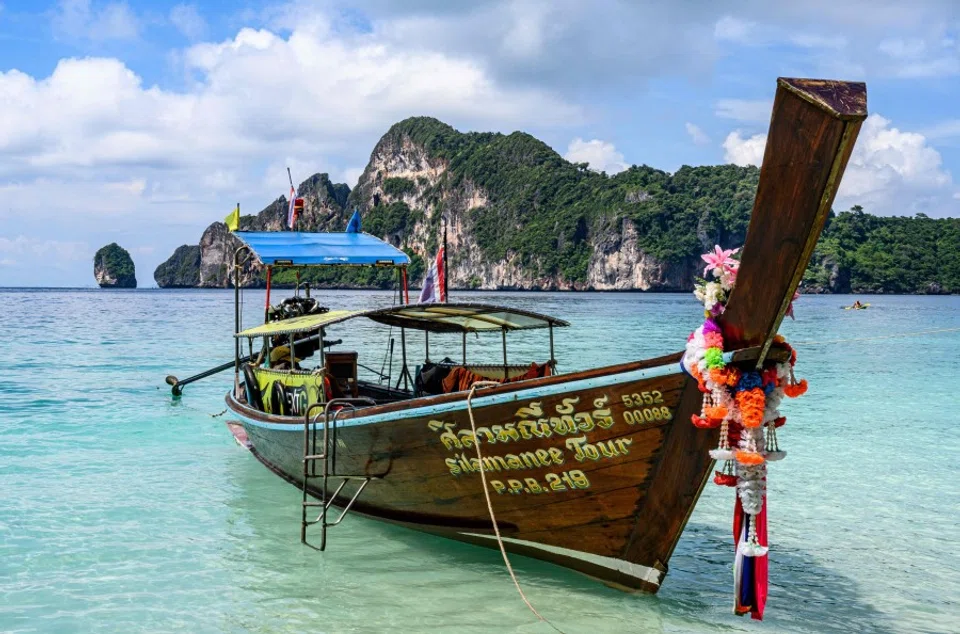Thailand's Kra canal project: Game changers and China's involvement

Few mega construction projects have been on the drawing board for as long as Thailand's Kra canal. The idea of cutting a waterway across the Isthmus of Kra in the Upper South of the country that would link the Gulf of Thailand with the Andaman Sea-and hence the Pacific and Indian Oceans-was first proposed more than 300 years ago. Since then the project has been repeatedly revived, resulting in a series of expensive engineering surveys and feasibility studies, before being quietly dropped.
The arguments for and against a Kra canal are longstanding and well-rehearsed.
Proponents of the canal point to the economic and strategic benefits that Thailand would accrue. They argue that the construction of the 100-kilometre canal, and related industrial infrastructure such as ports, manufacturing plants and oil refineries, would create jobs for tens of thousands of Thai workers, stimulate the economy (especially during periods of economic downturn) and, over the long-term, generate a lucrative revenue stream from the collection of shipping tolls. Militarily, the canal would enable the Thai navy to move ships quickly from one coast to the other during times of crisis. In addition, a Kra canal would also provide a faster and thus cheaper route between the Indian Ocean and the South China Sea, thus providing a viable alternative to the increasingly congested and "pirate infested" Straits of Malacca.
Since the 2014 coup, the Kra canal proposal has resurfaced once again. This time the project's backers argue that the circumstances favouring the canal are more propitious
Detractors of the canal remain unconvinced. Their main argument is that a Kra canal is commercially unviable: that the massive construction costs could not be clawed back from toll fees as shipping companies would be reluctant to bear additional costs just to save two or three days sailing time (especially at a time when the price of oil is low)-a situation quite unlike the Suez and Panama Canals which save vessels weeks of extra time at sea.

With regard to the strategic benefits, critics argue that Thailand faces no threats from its neighbours, a canal would cleave the country into two halves and thus embolden separatists in the Far South, and the ownership and operation of the waterway would inevitably become entangled in Great Power rivalry.
Since the 2014 coup, the Kra canal proposal has resurfaced once again. This time the project's backers argue that the circumstances favouring the canal are more propitious, for three main reasons. First, the Kingdom has a new monarch who needs to cement his legacy. Second, China is keen to invest in regional infrastructure projects such as the Kra canal as part of its Belt and Road Initiative (BRI). And third, the Thai government has promulgated a two-decade national development strategy which emphasises the importance of global connectivity initiatives.
However, these three potential game changers do not significantly enhance the canal's prospects.
Three potential game changers
First, Thailand's new monarch. In December 2016, 50 days after the death of his father King Bhumipol Adulyadej, King Vajiralongkorn became the tenth king of the Chakri Dynasty. His coronation took place in May 2019. At 64, King Vajiralongkorn was the oldest Thai monarch to ascend the throne. The realisation of the Kingdom's three-centuries-old dream to build a Kra canal would cement his legacy, especially if the canal were to be named after him. However, as the King has never mentioned the project in public it is unclear whether it has his personal backing or not. If it does, Thailand's ruling elite might take the project more seriously.
Second, China's Belt and Road Initiative (BRI). Due to its geographic position in the heart of mainland Southeast Asia, China views Thailand as a key node in its trillion-dollar global infrastructure project. Since the 2014 coup, the government of Prime Minister Prayut Chan-ocha has been a keen supporter of BRI. However, China's most high-profile BRI project in Thailand, a High-Speed Rail (HSR) network, has been repeatedly delayed due to disagreements over financing, technology and operational issues. Domestically the HSR has been heavily criticised for its excessive cost, for its lack of transparency and for making Thailand too dependent on China. Nevertheless, the two main advocates of the canal, the Thai-Chinese Cultural and Economic Association (TCCEA) and Thai Canal Association for Study and Development (TCASD), have both suggested that China could finance a Kra canal as part of one of the BRI's six designated corridors, the China-Indochina Peninsula Economic Corridor.
However, Beijing has never officially promoted the canal as a BRI project. Nevertheless, in the view of many Thai analysts, Beijing is quietly pushing Chinese companies to support the canal.
China's views on the Kra canal are opaque. In the mid-2000s, Chinese strategic analysts suggested the canal could enhance the country's energy security by reducing the need for Chinese-flagged oil tankers to transit through the Malacca Straits which was "controlled" by the United States.
Thailand's then Deputy Prime Minister and Defence Minister Chavalit Yongchaiyudh proposed building a canal, and he promoted the Kra canal as a money spinner that would create thousands of jobs and pay for itself within a short period of time. At the time, it was reported that China supported the idea, but ultimately baulked at the US$20 billion price tag. However, a decade later, China is much more eager to finance large infrastructure projects as part of BRI.
Moreover, while the so-called "Malacca Dilemma" was always exaggerated, strategic analysts in China still view a Kra canal as a useful way to achieve "risk dispersal". However, Beijing has never officially promoted the canal as a BRI project. Nevertheless, in the view of many Thai analysts, Beijing is quietly pushing Chinese companies to support the canal.
Third, Thailand's twenty-year National Strategy. Mandated by the 2017 Constitution, and published in October 2018 by the Office of the National Economic and Social Development Board (NESDB), the National Strategy lays out a vision for the Kingdom's socio-economic development from 2018 until 2037. All government policies must accord with the National Strategy and the Senate monitors compliance with it. The National Strategy proposes that Thailand develop high-quality infrastructure to connect the country with the rest of the world. Although it does not mention a waterway across the Kra Isthmus specifically, a canal could be classed as a high-quality connectivity project. Shrewdly, the TCASD submitted its proposal for a Kra canal to the NESDB in December 2017.
Thai initiative or a Chinese one
Prime Minister Prayut's response to the new push to build a Kra canal has been cautious: he has neither endorsed it nor rejected it. In February 2018, his spokesman said that while the idea was not a priority, the government was reviewing it. In October 2018, it was reported that Prayut had told the NESDB to examine the TCASD's proposal.
Several factors account for Prayut's caution.
First, he does not wish to alienate those who support the canal, including members of the business community and his former colleagues from the armed forces, by ruling it out.
Second, since 2014 Prayut has been preoccupied with creating a new political structure which ensures military dominance and defenestrates those who oppose it. The 24 March 2019 elections were the culmination of this process. As such, he has had little time to evaluate the pros and cons of a canal.
Third, and most importantly, the Prayut government needs to consider a host of complex and intertwined economic, domestic and geopolitical factors before endorsing such a massive and controversial construction project.
A Kra canal as part of China's BRI would also elicit a negative response from Thailand's ally, the United States, given the Trump administration's criticism of the policy as "debt trap diplomacy".
As always, the most critical issues are economic: how would the canal be financed and would it be economically viable? Reliance on China-even if Beijing were willing to underwrite the US$20-30 billion mega project-would likely be unpopular at home given the controversies surrounding the HSR and Thailand's purchase of Chinese submarines. (Thailand's 2015 decision to acquire three diesel-electric submarines from China for US$1.03 billion was the most expensive and significant defence procurement decision in the country's history. The contract has been criticised within Thailand for its lack of transparency, for being too expensive and for lacking a strong strategic rationale.)
If the proposal is to elicit national support, it must be seen as being a wholly-owned Thai initiative and not a Chinese one. A Kra canal as part of China's BRI would also elicit a negative response from Thailand's ally, the United States, given the Trump administration's criticism of the policy as "debt trap diplomacy". Thai strategic analysts worry that a Kra canal might become the object of Sino-US rivalry, much as the proposed project became embroiled in Franco-British competition in the nineteenth century.
Surprisingly, some Thais still express concern that a canal would divide the country and embolden southern separatists. More realistically, others worry that the 100-km long waterway would be vulnerable to attacks from Malay-Muslim insurgents. Bangkok must also factor in the commercial sensitivities of its neighbours, especially Singapore and Malaysia, as a canal could divert valuable shipping away from their ports. The Thai government must also consider the environmental impact of this massive construction project and how it would affect the country's lucrative tourism industry.

An unfulfilled Kra canal dream
Arguments for and against the construction of a Kra canal continue to be recycled. Potential game changers have altered the context of the debate slightly but not decisively. If the project is to go ahead it will need the imprimatur of the monarch, and thus far King Vajiralongkorn has shown no inclination to support it.
A Chinese-funded waterway would be too controversial at home and set back Thailand's relations with America which have only just recovered from the 2014 coup. A crucial factor in moving the canal forward would be to identify it as a key infrastructure project under the National Strategy. However, as the Prayut government remains preoccupied with political difficulties, the country's budget deficit grows, and the global economy faces strong headwinds caused by the US-China trade war (which has already drastically reduced demand for shipping), neither the political will nor the financial resources are currently available to realise Thailand's Kra canal dream.
This article was first published as ISEAS Perspective 2019/76 "Thailand's Perennial Kra Canal Project: Pros, Cons and Potential Game Changers" by Ian Storey.
